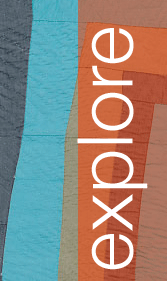ARCHIVAL SOURCES
Images
Birmingham Public Library (BPL)
Francis Xavier Walter Collection: Papers of the Selma Inter-Religious Project, 1965-1974 (including The Freedom Quilting Bee papers)
In the files of the Selma Inter-Religious Project, we found papers from the Freedom Quilting Bee in Gee's Bend. These papers include explicit notes on how it was suggested local quilting traditions be altered to make quilts more marketable. In these files as well, we have discovered a cache of photographs by Jim Peppler. Mr Peppler is currently a photographer for Newsday on Long Island, NY, but from 1965 to 1968 he was a photographer for the civil rights weekly newspaper, The Southern Courier, Montgomery, Alabama. Mr. Peppler's photographs of people and quilts at the festival are extremely important to our project for several reasons.
Taken during the economic crisis that followed the march on Selma, the photos depict the historic Freedom Quilting Bee Festival at Gee's Bend. The photos are important to us for two reasons. The first is that they put a face on African American women's entrepreneurship as a force within local Civil Rights movements. The women and their families at the festival are selling quilts to raise money after they were placed in economic peril following their voter registration. Unlike many other photographs of people from Gee's Bend, here whole families are represented and the emphasis is on their local culture rather than their impoverishment.
Second: these photographs are extremely important as an historical record of quilt making practices in the mid-1960s. What we see here are complex patterns such as the extremely rare Pine Burr quilt pattern. This, the state quilt of Alabama, has roughly 24,000 one-inch pieces designed in a three-dimensional pattern. Also pictured is the large scale Chestnut Bud pattern neither of these patterns appear in the current exhibit and neither is currently extant at Gee's Bend as only two women knew how to make them. These pictures of the rare, now vanished quilts are extremely important to understanding the quilt making practices of Gee's Bend. Mr Peppler has given us full permission to use his pictures.
Information on the BPL Archives
Library of Congress (Online)
Collection houses all images from the Farm Security Administration (FSA) including those from Alabama and Gee's Bend.
America from the Great Depression to World War II
Images by Arthur Rothstein from Gee's Bend
Images by Arthur Rothstein from Alabama
Find out about Rights and Reproductions
Search for Rothstein and Alabama to get a larger context of images, Rothstein and Gee's Bend for a few photos specifically from Gee's Bend.
Auburn University
Alabama Cooperative Extension Service Files, Special Collections
Collection houses images from the Home Demonstration and Farm Demonstration Agents in Alabama. Specifically, photographs from the 1930s/40s offer excellent points of comparison to the FSA photos.
Oral Histories
Gee's Bend Project
Collection in Birmingham houses images and oral histories from the Gee's Bend community, gathered in the late 1970s by Kathryn Windham Tucker (oral histories) and John Reese (photographer). Images provide a strong series to compare the FSA photographs with. We plan to use this collection in several ways. By allowing students to listen to segments on tape and compare to corrected and uncorrected transcripts, we have a unique opportunity to discuss voice in language arts and to discuss subject position in history and social studies.


